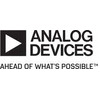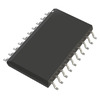Manufacturer Part Number
AD7304BRUZ
Manufacturer
Analog Devices
Introduction
The AD7304 is a quad, 8-bit digital-to-analog converter designed for data acquisition systems and digital signal processing.
Product Features and Performance
Quad 8-bit DAC channels
Fast settling time of 2µs
Buffered voltage output
SPI data interface for digital communication
R-2R DAC architecture offers precision and repeatability
Operating temperature range from -40°C to 85°C for reliability in varied environments
Product Advantages
Multiple DACs in a single package for compact design
Independent DAC channels allow for complex signal generation
No differential output simplifies the circuit design
Can be powered by a single supply or dual supplies for design flexibility
Key Technical Parameters
Number of Bits: 8
Number of D/A Converters: 4
Settling Time: 2µs
Output Type: Voltage - Buffered
Reference Type: External
Voltage - Supply, Analog: 2.7V ~ 5.5V, ±5V
Voltage - Supply, Digital: 2.7V ~ 5.5V
INL/DNL (LSB): ±1 (Max)
Quality and Safety Features
Consistent performance across operating temperature range
Designed according to industry standards for electronic components
Compatibility
Surface Mount 16-TSSOP package compatible with standard PCB manufacturing processes
SPI interface compatible with most microcontrollers and digital systems
Application Areas
Suitable for telecommunications
Instrumentation and control systems
Portable and battery-powered equipment
Industrial process control
Product Lifecycle
Active product status indicates ongoing production and support
No indication of imminent discontinuation
Replacements or upgrades can be sourced based on base product number AD7304
Several Key Reasons to Choose This Product
High integration with four DACs reduces overall component count
Fast settling time enables rapid signal changes for real-time applications
Flexible supply voltage range supports use in diverse electronic systems
Consistent output performance over a wide temperature range ensures reliability
SPI interface facilitates easy integration into digital systems




 AD7303BRZ-REEL7Analog Devices
AD7303BRZ-REEL7Analog Devices AD7304BRZAnalog Devices Inc.IC DAC 8BIT V-OUT 16SOIC
AD7304BRZAnalog Devices Inc.IC DAC 8BIT V-OUT 16SOIC AD7305BRZAnalog Devices Inc.IC DAC 8BIT V-OUT 20SOIC
AD7305BRZAnalog Devices Inc.IC DAC 8BIT V-OUT 20SOIC AD7303BRZAnalog Devices Inc.IC DAC 8BIT V-OUT 8SOIC
AD7303BRZAnalog Devices Inc.IC DAC 8BIT V-OUT 8SOIC